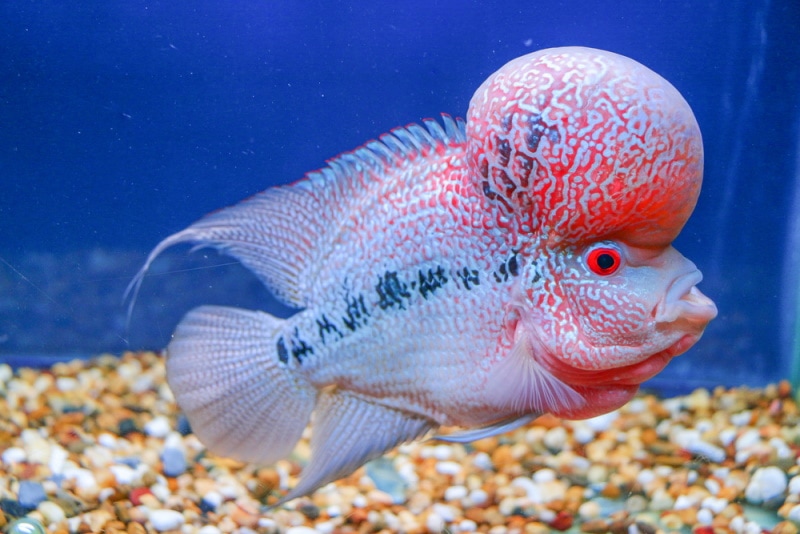What’s the Ideal Temperature for a Turtle Tank? What You Need to Know!
Updated on

Turtles are reptiles so they regulate their body temperature using external heat sources. They depend on an adequate environmental temperature to survive. This mechanism of body temperature control is called ectothermy1. For this reason, it’s crucial to set your turtle tank to the proper temperature range; otherwise, your reptile’s health may deteriorate fast, and it can even die.
For most species of turtles, the ideal temperature range is 75–85°F. You must also provide a warm basking area with a heat source, as well as a cool area for thermoregulation. The ideal temperature will be dependent on the species that you have. Check with your reptile specialist or veterinarian for advice on tank set up.
Ideal Temperature Range for a Turtle Tank
| Tank Area | Temperature Range |
| Water | 72–80°F |
| Air | 75–85°F |
| Basking area | 75–88°F |
| Nighttime | 65–70°F |

How Do Turtles Regulate Their Body Temperatures?
Turtles are reptiles that have a bony shell covering their bodies. They are ectothermic, which means they do not produce their own body heat and therefore, depend entirely on the ambient temperature. Indeed, environmental temperature affects the activity levels of turtles and other reptiles: When the temperature drops too much, these animals become lethargic and more vulnerable to external threats. Their physiological activity slows down, and their immune and digestive systems are also affected.
Therefore, reptiles must use the hot rays of the sun to keep warm. But for most pet turtles, access to sunlight is limited or absent. This is why adding a heat source to their tank is crucial, so they can regulate their body temperature. It is also necessary to monitor the temperature of the water and basking areas.
The temperature of the basking area should be higher than other areas of the tank. Also, the water temperature should be lower than the air temperature to enable the turtle to cool off as needed.

Ideal Air Temperature for a Turtle Tank
The overall air temperature in a turtle tank should be between 75°F and 85°F. You should research the specific needs of your turtle species, though most will be within that range.
However, be aware that baby turtles need a warmer temperature than adults — about 5 degrees warmer. An adjustable heater is required to ensure that your turtles receive the proper amount of heat as they grow.
Ideal Water Temperature for a Turtle Tank
Water temperatures should range between 75°F and 82°F, but some species, such as the red-eared slider (Trachemys scripta elegans), can tolerate temperatures up to 85°F.
An effective way to control water temperature is to use a submersible aquarium heater suitable for the size of your turtle tank. However, keep the heating element away from your turtles to avoid burns. To do this, you can cover the heater with a PVC pipe.

Ideal Basking Area Temperature for a Turtle Tank
The basking area temperature needs to be the warmest part of the tank and stay between 75°F and 88°F. When setting up your turtle tank, provide a warm area away from a cooler spot to establish a heat gradient in the tank. This way, your turtle can regulate its body temperature as it moves through the different zones.
Nighttime Temperature
At night, turtles don’t need extra light or heat as long as the temperature doesn’t drop below 65–70°F.
Do Pet Turtles Need UV Light?
In addition to heat, turtles need UVB rays to absorb vitamin D3 and properly metabolize calcium and other essential nutrients. Without vitamin D3, the bones and shells of your turtles will weaken, which will considerably reduce their life expectancy.
- Related Read: 10 Best UVB Lights for Turtles

Tips for Keeping Your Turtle Tank at the Ideal Temperature
- Monitor temperatures in all areas using thermometers. Place one thermometer in the cooler area of the tank and another in the basking spot.
- Purchase a water heater that is fully submersible and suitable for the size of your tank.
- Use a 100-watt incandescent bulb or another type of ceramic heat bulb to provide a focal heat source.
- Provide barriers around heaters to prevent your turtles from getting burned.
- Be sure to provide a 5–10°F temperature drop at night.
- Consult a veterinarian with experience with reptiles if you have questions about proper lighting or housing for your pet turtles.
Conclusion
Turtles require more care and maintenance than most people think. So, before bringing home a new pet turtle, be sure to research the specific tank temperature requirements for your desired species. As a general rule, though, most turtles will do well with a tank temperature range of 75–85°F.
Related Reads:
- 6 Aquatic Pet Turtle Diseases to Watch Out For (Vet Answer)
- Can I Rehome or Surrender My Turtle? Expert Advice & FAQs
Featured Image Credit: Megan Czarnocki, Shutterstock












